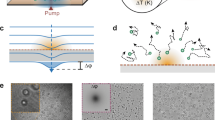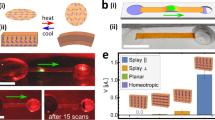Abstract
We demonstrate a tunable in-plane optofluidic microlens with a 9× light intensity enhancement at the focal point. The microlens is formed by a combination of a tunable divergent air–liquid interface and a static polydimethylsiloxane lens, and is fabricated using standard soft lithography procedures. When liquid flows through a straight channel with a side opening (air reservoir) on the sidewall, the sealed air in the side opening bends into the liquid, forming an air–liquid interface. The curvature of this air–liquid interface can be conveniently and predictably controlled by adjusting the flow rate of the liquid stream in the straight channel. This change in the interface curvature generates a tunable divergence in the incident light beam, in turn tuning the overall focal length of the microlens. The tunability and performance of the lens are experimentally examined, and the experimental data match well with the results from a ray-tracing simulation. Our method features simple fabrication, easy operation, continuous and rapid tuning, and a large tunable range, making it an attractive option for use in lab-on-a-chip devices, particularly in microscopic imaging, cell sorting, and optical trapping/manipulating of microparticles.





Similar content being viewed by others
References
Ahmed D, Mao X, Shi J, Juluri BK, Huang TJ (2009a) A millisecond micromixer via single-bubble-based acoustic streaming. Lab Chip 9:2738–2741
Ahmed D, Mao X, Juluri BK, Huang TJ (2009b) A fast microfluidic mixer based on acoustically driven sidewall-trapped microbubbles. Microfluid Nanofluid 7:727–731
Baird E, Young P, Mohseni K (2007) Electrostatic force calculation for an EWOD-actuated droplet. Microfluid Nanofluid 3:635–644
Blakely JT, Gordon R, Sinton D (2008) Flow-dependent optofluidic particle trapping and circulation. Lab Chip 8:1350–1356
Chiou PY, Ohta AT, Wu MC (2005) Massively parallel manipulation of single cells and microparticles using optical images. Nature 436:370–372
Chronis N, Liu GL, Jeong KH, Lee LP (2003) Tunable microdoublet lens array. Opt Express 11:2370–2378
Cui X, Lee LM, Heng X, Zhong W, Sternberg PW, Psaltis D, Yang C (2008) Lensless high-resolution on-chip optofluidic microscopes for Caenorhabditis elegans and cell imaging. Proc Natl Acad Sci USA 105:10670–10675
Domachuk P, Cronin-Golomb M, Eggleton B, Mutzenich S, Rosengarten G, Mitchell A (2005) Application of optical trapping to beam manipulation in optofluidics. Opt Express 13:7265–7275
Dong L, Jiang H (2007) Tunable and movable liquid microlens in situ fabricated within microfluidic channels. Appl Phys Lett 91:041109
Dong L, Agarwal AK, Beebe DJ, Jiang H (2006) Adaptive liquid microlenses activated by stimuli-responsive hydrogels. Nature 442:551–554
Erickson D, Mandal S, Yang AHJ, Cordovez B (2008) Nanobiosensors: optofluidic, electrical and mechanical approaches to biomolecular detection at the nanoscale. Microfluid Nanofluid 4:33–52
Godin J, Lien V, Lo YH (2006) Demonstration of two-dimensional fluidic lens for integration into microfluidic flow cytometers. Appl Phys Lett 89:061106
Grilli S, Miccio L, Vespini V, Finizio A, Nicola SD, Ferraro P (2008) Liquid micro-lens array activated by selective electrowetting on lithium niobate substrates. Opt Express 16:8084–8093
Groisman A, Zamek S, Campbell K, Pang L, Levy U, Fainman Y (2008) Optofluidic 1 × 4 Switch. Opt Express 16:13499–13508
Hecht E (2001) Optics, Pearson Education, pp 159–161
Heng X, Erickson D, Baugh LR, Yaqoob Z, Sternberg PW, Psaltis D, Yang C (2006) Optofluidic microscopy—a method for implementing a high resolution optical microscope on a chip. Lab Chip 6:1274–1276
Horowitz VR, Awschalom DD, Pennathur S (2008) Optofluidics: field or technique? Lab Chip 8:1856–1863
Hunt HC, Wilkinson JS (2008) Optofluidic integration for microanalysis. Microfluid Nanofluid 4:53–79
Kuiper S, Hendriks BHW (2004) Variable-focus liquid lens for miniature cameras. Appl Phys Lett 85:1128–1130
Lapsley MI, Lin SCS, Mao X, Huang TJ (2009) An in-plane, variable optical attenuator using a fluid-based tunable reflective interface. Appl Phys Lett 95:083507
Lee SW, Lee SS (2007) Focal tunable liquid lens integrated with an electromagnetic actuator. Appl Phys Lett 90:121129
Levy U, Shamai R (2007) Tunable optofluidic devices. Microfluid Nanofluid 4:97–105
Li ZY, Zhang ZY, Emery T, Scherer A, Psaltis D (2006) Single mode optofluidic distributed feedback dye laser. Opt Express 14:696–701
Lim JM, Kim SH, Choi JH, Yang SM (2008) Fluorescent liquid-core/aircladding waveguides towards integrated optofluidic light sources. Lab Chip 8:1580–1585
Lopez CA, Lee CC, Hirsa AH (2005) Electrochemically activated adaptive liquid lens. Appl Phys Lett 87:134102
Mao X, Waldeisen JR, Juluri BK, Huang TJ (2007) Hydrodynamically tunable optofluidic cylindrical microlens. Lab Chip 7:1303–1308
Mao X, Lin SCS, Dong C, Huang TJ (2009a) Single-layer planar on-chip flow cytometer using microfluidic drifting based three-dimensional (3D) hydrodynamic focusing. Lab Chip 9:1583–1589
Mao X, Lin SCS, Lapsley MI, Shi J, Juluri BK, Huang TJ (2009b) Tunable liquid gradient refractive index (L-GRIN) lens with two degrees of freedom. Lab Chip 9:2050–2058
Miccio L, Finizio A, Grilli S, Vespini V, Paturzo M, Nicola DS, Ferraro P (2009a) Tunable liquid microlens arrays in electrode-less configuration and their accurate characterization by interference microscopy. Opt Express 17:2487–2499
Miccio L, Paturzo M, Grilli S, Vespini V, Ferraro P (2009b) Hemicylindrical and toroidal liquid microlens formed by pyro-electro-wetting. Opt Lett 34:1075–1077
Monneret S, Belloni F, Soppera O (2007) Combining fluidic reservoirs and optical tweezers to control beads/living cells contacts. Microfluid Nanofluid 3:645–652
Pang L, Levy U, Campbell K, Groisman A, Fainman Y (2004) Set of two orthogonal adaptive cylindrical lenses in a monolith elastomer device. Opt Express 13:9003–9013
Psaltis D, Quake SR, Yang C (2006) Developing optofluidic technology through the fusion of microfluidics and optics. Nature 442:381–386
Ren H, Wu ST (2007) Variable-focus liquid lens. Opt Express 15:5931–5936
Rosenauer M, Vellekoop MJ (2009) 3D fluidic lens shaping—a multiconvex hydrodynamically adjustable optofluidic microlens. Lab Chip 9:1040–1042
Schmidt H, Hawkins AR (2008) Optofluidic waveguides: I. Concepts and implementations. Microfluid Nanofluid 4:3–16
Seow YC, Liu AQ, Chin LK, Li XC, Huang HJ, Cheng TH, Zhou XQ (2008) Different curvature of tunable liquid microlens via the control of laminar flow rate. Appl Phys Lett 93:084101
Shi J, Hsiao VKS, Huang TJ (2007) Nanoporous polymeric transmission gratings for high-speed humidity sensing. Nanotechnology 18:465501
Shi J, Hsiao VKS, Walker TR, Huang TJ (2008a) Humidity sensing based on nanoporous polymeric photonic crystals. Sens Actuators B Chem 129:391–396
Shi J, Mao X, Ahmed D, Colletti A, Huang TJ (2008b) Focusing microparticles in a microfluidic channel with standing surface acoustic waves (SSAW). Lab Chip 8:221–223
Shi J, Ahmed D, Mao X, Lin SCS, Huang TJ (2009a) Acoustic tweezers: patterning cells and microparticles using standing surface acoustic waves (SSAW). Lab Chip 9:2890–2895
Shi J, Huang H, Stratton Z, Lawit A, Huang Y, Huang TJ (2009b) Continuous particle separation in a microfluidic channel via standing surface acoustic waves (SSAW). Lab Chip 9:3354–3359
Shopova SI, Zhou H, Fan X, Zhang P (2007) Optofluidic ring resonator based dye laser. Appl Phys Lett 90:221101
Sinton D, Erickson D, Li D (2003) Micro-bubble lensing induced photobleaching (m-BLIP) with application to microflow visualization. Exp Fluids 35:178–187
Song C, Nguyen NT, Tan SH, Asundi AK (2009) Modelling and optimization of micro optofluidic lenses. Lab Chip 9:1178–1184
Tang SKY, Stan CA, Whitesides GM (2008) Dynamically reconfigurable liquidcore liquid-cladding lens in a microfluidic channel. Lab Chip 8:395–401
Tovar AR, Lee AP (2009) Lateral cavity acoustic transducer. Lab Chip 9:41–43
Wang MM, Tu E, Raymond DE, Yang JM, Zhang H, Hagen N, Dees B, Mercer EM, Forster AH, Kariv I, Marchand PJ, Butler WF (2005) Microfluidic sorting of mammalian cells by optical force switching. Nat Biotechnol 23:83–87
Wolfe DB, Conroy RS, Garstecki P, Mayers BT, Fischbach MA, Paul KE, Prentiss M, Whitesides GM (2004) Dynamic control of liquid-core/liquid-cladding optical waveguides. Proc Natl Acad Sci USA 34:12434–12438
Wu J, Cui X, Lee LM, Yang C (2008) The application of Fresnel zone plate based projection in optofluidic microscopy. Opt Express 16:15595–15602
Xia YN, Whitesides GM (1998) Soft lithography. Ann Rev Mater Sci 28:153–184
Yang AHJ, Moore SD, Schmidt BS, Klug M, Lipson M, Erickson D (2009) Optical manipulation of nanoparticles and biomolecules in sub-wavelength slot waveguides. Nature 457:71–75
Yin D, Lunt EJ, Rudenko MI, Deamer DW, Hawkins AR, Schmidt H (2007) Planar optofluidic chip for single particle detection, manipulation, and analysis. Lab Chip 7:1171–1175
Zhang DY, Lien V, Berdichevsky Y, Choi J, Lo YH (2003) Fluidic adaptive lens with high focal length tenability. Appl Phys Lett 82:3171–3172
Zourob M, Mohr S, Brown BJT, Fielden PR, McDonnell MB, Goddard NJ (2005) An integrated optical leaky waveguide sensor with electrically induced concentration system for the detection of bacteria. Lab Chip 5:1360–1365
Acknowledgments
We thank Xiaole Mao and Aitan Lawit for helpful discussion. This research was supported by National Science Foundation (ECCS-0824183, ECCS-0801922, and ECCS-0609128) and the Penn State Center for Nanoscale Science (MRSEC). Components of this work were conducted at the Penn State node of the NSF-funded National Nanotechnology Infrastructure Network.
Author information
Authors and Affiliations
Corresponding author
Rights and permissions
About this article
Cite this article
Shi, J., Stratton, Z., Lin, SC.S. et al. Tunable optofluidic microlens through active pressure control of an air–liquid interface. Microfluid Nanofluid 9, 313–318 (2010). https://doi.org/10.1007/s10404-009-0548-9
Received:
Accepted:
Published:
Issue Date:
DOI: https://doi.org/10.1007/s10404-009-0548-9




